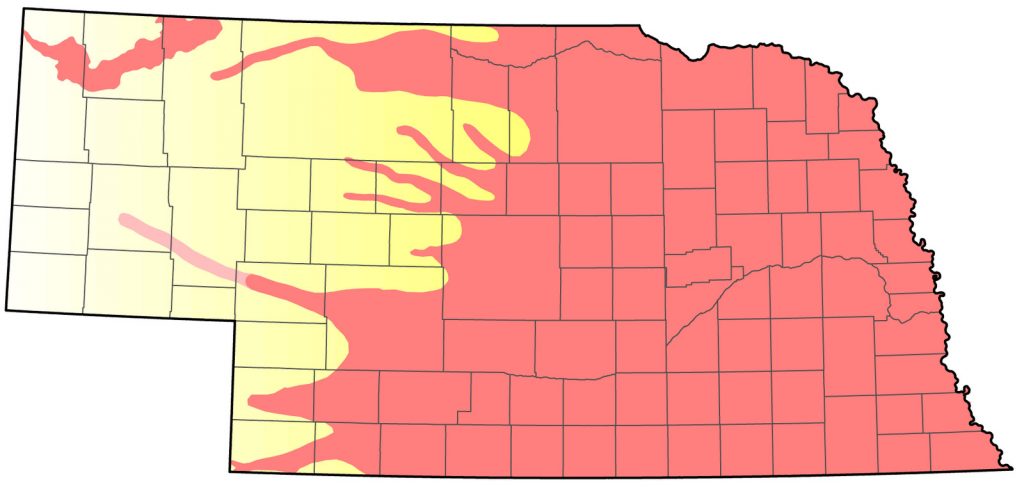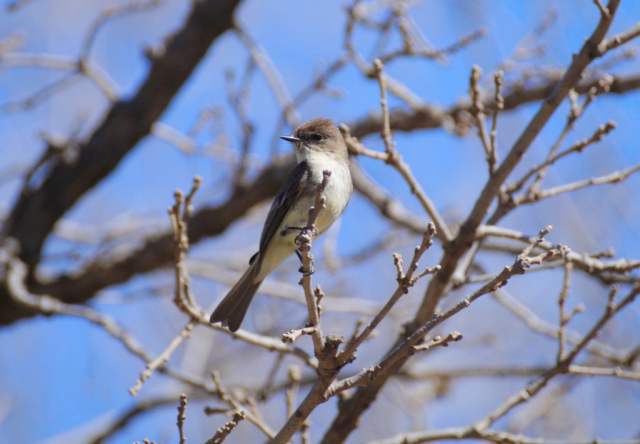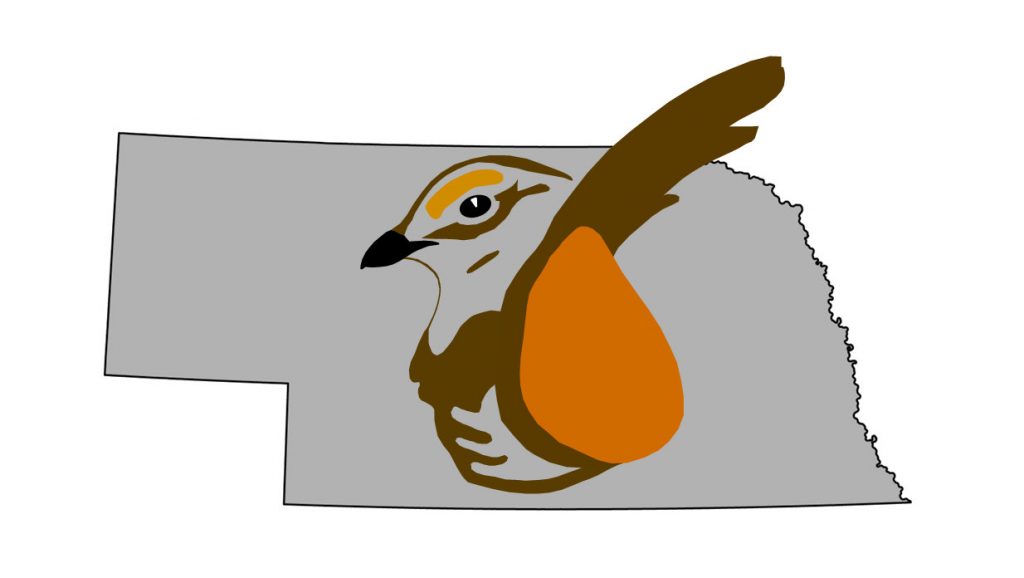Sayornis phoebe
Status: Common regular spring and fall migrant east and central, uncommon west. Fairly common regular breeder east and east-central, uncommon west-central and Pine Ridge, rare elsewhere.

Documentation: Specimen: UNSM ZM6367, 21 Mar 1903 Lancaster Co.
Taxonomy: No subspecies are recognized (Gill et al 2022).
Eastern Phoebe occasionally hybridizes with Black Phoebe; there are no records for Nebraska, but several in Colorado for the Front Range and southeastern plains (eBird.org, accessed Jul 2023).
Spring: Mar 8, 8, 8 <<<>>> summer (south, east), Mar 13, 13, 14 <<<>>> summer (north, west)
Earlier dates in the south and east are 2 Mar 2024 Gage Co, 4 Mar 2023 Lancaster Co, 5 Mar 2017 Webster Co, and 6 Mar 2016 Buffalo Co.
Earlier dates in the north and west are 9 Mar 2016 Greeley Co, and 10 Mar 2010 Garfield Co.
Eastern Phoebe is the earliest-arriving flycatcher, arriving in mid-Mar, later in the north and west.
Several observers in spring 2021 noted lower Eastern Phoebe numbers and this impression was supported by a simple compilation with controls by Joel Jorgensen of numbers of Eastern Phoebes reported to eBird for the last four years that showed 371 in 2018, 401 in 2019, 512 in 2020, and 265 in 2021, a 48% decline 2020 to 2021. The drop was attributed by some to unusually persistent cold temperatures affecting the food sources of this early migrant.
- High counts: 50 in Knox Co 31 Mar 2012, “a few dozen” in Fontenelle Forest, Sarpy Co 11 Apr 2013, 25 at Fremont Lakes SRA, Dodge Co 22 Apr 2018, 13 at Heron Haven, Douglas Co 15 Apr 2018, and 12 at Verdon Lake SRA, Richardson Co 9 Apr 2018.
Summer: BBS data indicate that Eastern Phoebe is most common in the east and east-central (Sauer et al 2017); it is least abundant in the western Sandhills and Panhandle away from the North Platte River Valley and the Pine Ridge (eBird.org, accessed Nov 2023). Where it occurs in the western half of Nebraska, Eastern Phoebe tends to be associated with river valleys, whereas in the eastern half of the state it is widespread. Based on available reports there is minimal evidence for westward expansion; it has traditionally been considered eastern in distribution (Bruner et al 1904, Thompson et al 2011, Weeks 2020). It is a “very rare summer resident” in Wyoming (Faulkner 2010). However, BBS trend analysis shows the species has increased annually by 2.04% (95% C.I.; 0.88, 3.3) during the period 1966-2019 (Sauer et al 2020).
Nests are typically constructed under bridges or abandoned or little-used buildings. In the Niobrara River Valley and at Valentine it breeds exclusively under bridges, which seems to be true in the northwest also (Rosche 1982). Short (1961) noted that where Say’s Phoebe occurred with Eastern Phoebe at Valentine, Say’s Phoebe utilized buildings only, while Eastern Phoebe was found at bridges. McClure (1946), however, found in central Nebraska that both species used bridges and buildings.
In the north it is common westward at least to eastern Cherry Co (Brogie and Mossman 1983), including Valentine (Short 1961), but rare along the Niobrara River Valley westward to the eastern Pine Ridge. In the western Sandhills it is rare (Rosche 1982); west of the Valentine area and Thomas Co, the few records are from Arthur Co Jul 2016, and along the west edge of the Sandhills in Sheridan Co Jun 2021 and Jul 2019 and at Crescent Lake NWR, Garden Co Jun 2015 (eBird.org, accessed Nov 2023). Glandon reported a nest with eggs near Stapleton, Logan Co 15 May 1939 (Glandon 1939).
In the Panhandle, it breeds in small numbers in Pine Ridge canyons and along tributaries of the White and Niobrara Rivers (Rosche 1982) but no nests have been found away from the Pine Ridge (Mollhoff 2022). A nest with recently fledged young was found in West Ash Creek Canyon, Dawes Co 8 Jun 2004 (Mollhoff 2005). In 2009 several birds were found in three BBA blocks in Dawes Co 13 Jun, including a nesting pair (Mollhoff 2016), and one was south of Chadron in Dawes Co 9 Jul 2016.
Eastern Phoebe is rare along the North Platte Valley; it is a rare summer resident in Keith Co (Rosche and Johnsgard 1984, Rosche 1994). The only Jun-Jul reports west of Keith Co are 6 Jun 2020 Ash Hollow SHP, Garden Co, 10 Jun 1990 Garden Co, 1 Jul 1968 Scotts Bluff Co, 1 Jul 1981 Garden Co, 4 Jul 2020 Banner Co, 19 Jul 2022 Garden Co, and 29 Jul 2010 Morrill Co.
Mollhoff (2016) shows confirmed breeding throughout the Republican and French Creek Valleys; it had not been reported from the latter by Mollhoff (2001).
- Breeding Phenology:
Nest Building: 2 Apr-16 Jun
Eggs: 7 Apr-11 Jul (usually double-brooded; Mollhoff 2022)
Nestlings: 9 May-9 Jul
Fledglings: 15 Jun-19 Sep
Fall: summer <<<>>> Nov 1, 1, 2
Later dates are 4 Nov 2008 Buffalo Co, 9 Nov 1989 Sarpy Co (Grzybowski 1990), 9 Nov 2018 Douglas Co, 17 Nov 1991 Lancaster Co (Grzybowski 1992), 24 Nov 2022 Sarpy Co, 17 Dec 2000 DeSoto CBC, Washington Co, 26 Dec 1960 Beatrice CBC, Gage Co, and 27 Dec 1986 Omaha CBC, Douglas Co.
Departure is in late Sep and early Oct, although in the east Eastern Phoebes may linger rather late.
- High counts: 10 at Heron Haven, Douglas Co 10 Sep 2020, 8 at Lincoln Saline Wetlands Nature Park, Lancaster Co 4 Oct 2017, 6 at Schramm Park SRA 20 Sep 2003, 6 in Otoe Co 24 Sep 2004, and 6 in Lancaster Co 11 Oct 2018.
Images
Abbreviations
BBA: Breeding Bird Atlas
BBS: Breeding Bird Survey
CBC: Christmas Bird Count
NWR: National Wildlife Refuge
SHP: State Historical Park
SRA: State Recreation Area
UNSM: University of Nebraska State Museum
Literature Cited
Brogie, M.A., and M.J. Mossman. 1983. Spring and summer birds of the Niobrara Valley Preserve, Nebraska: An annotated checklist. NBR 51: 44-51.
Bruner, L., R.H. Wolcott, and M.H. Swenk. 1904. A preliminary review of the birds of Nebraska, with synopses. Klopp and Bartlett, Omaha, Nebraska, USA.
Faulkner, D.W. 2010. Birds of Wyoming. Roberts and Company, Greenwood Village, Colorado, USA.
Gill, F., D. Donsker, and P. Rasmussen (Eds). 2022. IOC World Bird List (v 12.2). Doi 10.14344/IOC.ML.12.2. http://www.worldbirdnames.org/.
Glandon, E.W. 1939. Nesting of the Eastern Phoebe in Logan County. NBR 7: 31.
Grzybowski, J.A. 1990. Southern Great Plains Region. American Birds 44: 114-117.
Grzybowski, J.A. 1992. Southern Great Plains Region. American Birds 46: 113-117.
McClure, H.E. 1946. Phoebes in central Nebraska. Auk 63: 211-215.
Mollhoff, W.J. 2001. The Nebraska Breeding Bird Atlas 1984-1989. Nebraska Ornithologists’ Union Occasional Papers No. 7. Nebraska Game and Parks Commission, Lincoln, Nebraska, USA.
Mollhoff, W.J. 2005. The 2003-2004 Nebraska nest report. NBR 73: 15-19.
Mollhoff, W.J. 2016. The Second Nebraska Breeding Bird Atlas. Bull. Univ. Nebraska State Museum Vol 29. University of Nebraska State Museum, Lincoln, Nebraska, USA.
Mollhoff, W.J. 2022. Nest records of Nebraska birds. Nebraska Ornithologists’ Union Occasional Paper Number 9.
Rosche, R.C. 1982. Birds of northwestern Nebraska and southwestern South Dakota, an annotated checklist. Crawford, NE: Cottonwood Press.
Rosche, R.C. 1994. Birds of the Lake McConaughy area and the North Platte River valley, Nebraska. Published by the author, Chadron, Nebraska, USA.
Rosche, R.C., and P.A. Johnsgard. 1984. Birds of Lake McConaughy and the North Platte River Valley, Oshkosh to Keystone. NBR 52: 26-35.
Sauer, J.R., D.K. Niven, J.E. Hines, D.J. Ziolkowski, Jr, K.L. Pardieck, J.E. Fallon, and W.A. Link. 2017. The North American Breeding Bird Survey, Results and Analysis 1966 – 2015 (Nebraska). Version 2.07. USGS Patuxent Wildlife Research Center, Laurel, Maryland, USA.
Sauer, J.R., Link, W.A., and Hines, J.E. 2020. The North American Breeding Bird Survey, Analysis Results 1966 – 2019: U.S. Geological Survey data release, https://doi.org/10.5066/P96A7675.
Short, L.L., Jr. 1961. Notes on bird distribution in the central Plains. NBR 29: 2-22.
Weeks Jr., H.P. 2020. Eastern Phoebe (Sayornis phoebe), version 1.0. In Birds of the World (A. F. Poole, Editor). Cornell Lab of Ornithology, Ithaca, NY, USA. https://doi.org/10.2173/bow.easpho.01.
Recommended Citation
Silcock, W.R., and J.G. Jorgensen. 2024. Eastern Phoebe (Sayornis phoebe). In Birds of Nebraska — Online. www.BirdsofNebraska.org
Birds of Nebraska – Online
Updated 4 Jul 2024

